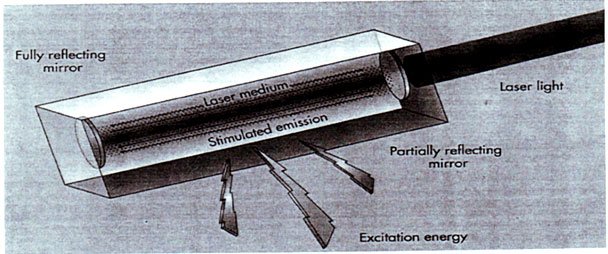Laser in Clinical Practice
LASER SCIENCE
Today modern medical science is changing according to the needs of the man to fulfill the dreams of their cosmetic and aesthetic appearance. Cosmetology is fast developing with the introduction of newer laser machines. The word LASER is an acronym for Light Amplification by the Stimulated Emission of Radiation.
LASER consists of an active medium(crystal, gas, dye) that is raised to an excited state by external energy sources such as a flash lamp or an electric discharge. The resulting process of stimulated emission in the active medium produces an abundance of photons of light all of the same wavelength. A pair of mirrors at each end of the active laser medium reflects the light back and forth on itself to increase the probability of stimulated emission. One of the mirrors allows a small fraction of the light to leak through. The resulting beam of light is the output beam of the laser.

Properties of Laser Light
Laser light has three unique properties:
1. It is collimated (directional) which means it travels in a single direction with very little divergence even over long distances.
2. It is monochromatic (Single colour/wavelength), consisting of one colour or narrow range of colours.
3. It is coherent (organized), which means all of the light waves move in phase together in both space and time ie. same frequency.

Types of Lasers
A wide range of lasers are available for medical applications. In general, medical lasers can be divided into four groups.
1. Gas lasers Co2, Argon, He, N2 etc.
2. Solid state lasers Er.YAG, Nd.YAG, KTP etc.
3. Liquid lasers Dye.
4. Diode lasers.
Laser Terminology
The most important terminology as far as laser treatment is concerned is TRT ( Thermal Relaxation Time) TRT can be defined as the time it takes for an object to cool down from 100º C to 63ºC. It is a rule that a smaller object cools faster than a larger object of the same material and shape which means that the smaller target has a shorter thermal relaxation time. This fact is important when the tissue needs to be heated to a desired temperature at a certain fluence setting. If the pulse width is too long, the tissue will start cooling itself via thermal conduction prior to the completion of a pulse causing a negative clinical effect. The second parameter that should be taken into consideration when estimating the TRT is the shape of the target tissue. A sphere (skin cells) having 360 degrees of cooling surface area cools faster than a cylinder (hair follicles). This allows hair follicle to retain its heat while the skin cells can cool itself much more efficiently. For this reason, parameters can be selected to destroy the follicle without causing damage to the skin. For targeting smaller structures, a shorter pulse duration and higher fluence are recommended.
Fluence (J/cms2)
Fluence refers to the amount of laser energy delivered per unit area. It is also called ‘dose of energy’ or ‘energy density’.
Fluence = Energy/Area
Fluence becomes larger as the spot size becomes smaller if all other parameters are held constant. Fluence is independent of spot size, frequency, and even the time of the treatment. This makes it useful for specifying general treatment characteristics. Other parameters must also be properly adjusted to efficaciously and safely apply laser treatment.
Pulse duration (ms) or Pulse width
Pulse duration and pulse width are synonymous terms, which refers to the temporal length of laser pulse; that is, the time during which the laser actually emits energy. If the pulse width is too long, the tissue will start cooling itself via thermal conduction prior to the completion of a pulse causing a negative clinical effect. For targeting smaller structures, a shorter pulse duration and higher fluence are recommended.
Spot Size (mm)
Laser beam spot size refers to the diameter of the laser beam on the target. By changing the laser beam spot size while keeping the laser pulse energy constant, the energy fluence can be changed substantially and thus the basic mechanism of laser beam interaction with the tissue (heating, ablation, vaporization) influenced. Larger the spot size the depth of laser beam will be more when compared to smaller size where the depth will be less.
Repetition rate – Frequency (Hz)
Medical lasers are usually operated in a repetitive pulse mode. Laser pulses are emitted periodically at a pulse rate, for example 10 pulses per second. Hertz (Hz) is the most commonly used unit for pulses per second.
Wavelength (nm)
Laser light can be represented as periodic waves of energy traveling through space. Wavelength refers to the physical distance between crests of successive waves in the laser beam. It is usually measured in nanometers. Laser machines have only single wavelength. The sunlight is having a range of wavelengths ie. 400 to 700 nanometers
Blog Categories
- Anti-Ageing (9)
- Body Contouring (5)
- CoolSculpting (3)
- Cosmetic Treatment (12)
- Fat Reduction (3)
- General (12)
- Hair Care (4)
- Laser Skin Treatments (7)
- Picocare (1)
- Product Launch (2)
- Sculpsure (2)
- Skin Brightening (6)
- Skin Care Tips (2)








